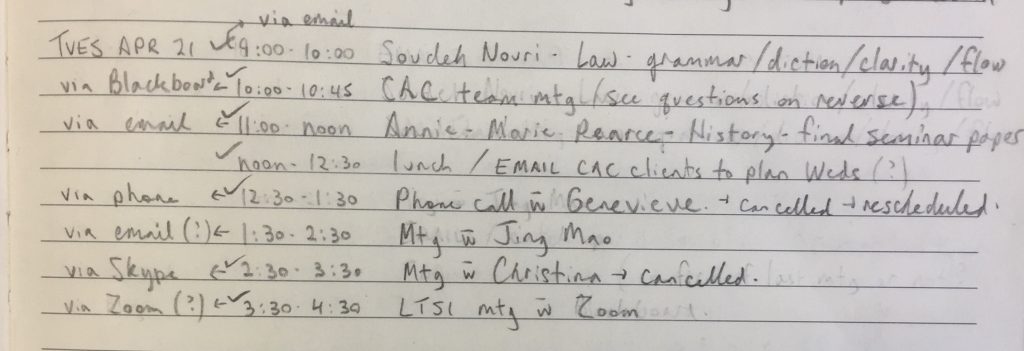“My contribution is a logbook entry composed one month after services migrated off-campus. This migration coincided with the closure of elementary schools, and the resulting complexities are visible in this entry: clients pivoted between Blackboard, Bluejeans, Skype, Zoom, while those left behind by the digital divide called my landline. This entry is a palimpsest of names written, erased, then rewritten in step with the volatility of that time – registering the collective attempt to regain ballast during a period of unprecedented precarity.” – Emily Arvay

Sample journal entry from Emily’s daily logbook during the COVID-19 lockdown and elementary school closures.
On this all-too-typical day, roughly a third of scheduled appointments were either cancelled or rescheduled. Also apparent in this logbook entry is the scheduling of a mid-morning team meeting and mid-afternoon division meeting likely purposed to troubleshoot some of these emergent complexities. Strikingly, the team meeting item is followed by a parenthetical note-to-self to discuss pressing technological or logistical questions jotted on the reverse page. Finally, this entry contains a lunchtime reminder to email clients booked for the following day to confirm a preferred modality of engagement. What cannot be discerned from this logbook entry is the context of school-aged children (then aged 6 and 11) thrust into homeschooling, and the subsequent array of platforms, user-IDs, passcodes, and electronic devices needed to fulfill age-appropriate literary and numeracy learning outcomes. In retrospect, the very act of keeping and updating this daily logbook was an adaptive attempt to restore some semblance of order to otherwise chaotic conditions.
Teaching strategies
In light of the aforementioned conditions, my teaching strategies shifted to accommodate student-identified needs and objectives. Academic skills workshops once held in-person migrated online and, in lieu of “four corners” think-pair-share activities and hardcopy handouts, I turned to Zoom breakout rooms and annotation tools to pique and sustain student engagement. Likewise, my tutoring strategies shifted: non-verbal cues previously perceivable during an in-person appointment proved much harder to discern over Zoom, and the warmth of tone previously established during an in-person consultation proved more difficult to convey in the comment “bubbles” applied to an uploaded draft. In response to such challenges, my teaching and tutoring strategies became more overt. Since I could no longer “sense” student receptivity, I would check-in more often with verbal elicitation questions. Since I could no longer establish a warm and welcoming rapport verbally, I peppered written feedback with intermittent praise. Though forged as an adaptive response to crises, these recently acquired teaching and tutoring strategies have permitted me to take more risks and be bolder in my engagements with students.

Emily Arvay
In my current role, I coordinate the CAC’s Learning Strategies program and provide UVic students with tailored academic support through individual tutorial appointments, academic communication workshops, and group-led English Conversational Cafés. To assist students with their academic goals, my teaching practice centres on strength-based and self-regulated approaches to learning. There is nothing I love more than to help students draw on their own strengths to excel in their upcoming academic presentations, papers, and assignments.